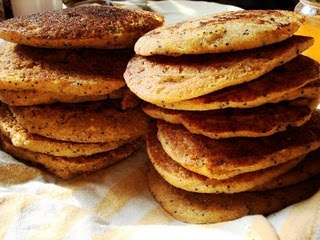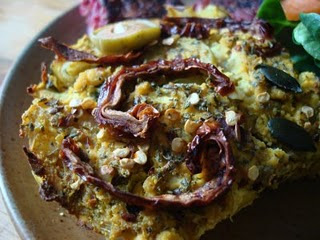Basic Soy Kefir
>> Sunday, February 22
Basic Soy Kefir
I read on Dom’s website (<-- at this site, scroll to bottom and click the link for seed/nut milk kefir, my link to it is not working at the moment) that kefir grains will not live long and happy lives in soy-only diets. I have no idea. I generally like water kefir more often than I like soymilk kefir, so I alternate my grains between the two. I don’t know if that’s a good idea or not, but I do it. And it seems to work.
Many of the same principles apply to kefir making as to yogurt making. You can look at Basic Soy Yogurt for information on choosing milk, cleanliness, etc. There are also some kefir-specific things you should know.
As kefir ferments, it creates carbonation in the milk, and causes pressure in sealed containers. If you seal the container (and I do, because I like those bubbles ☺), you should fill it only ¾ full to avoid explosions, no matter how cool creating your own explosives might seem.
If you keep making milk kefir, it’s a good idea to rinse the grains in room temperature, filtered water (unchlorinated). Otherwise, they can get a gooey layer on their surface which makes it hard for them to function.
I just feel silly writing more because Dom’s Kefir Making Site has all the information you could ever need and if you want to know more, check it out. Here is my extremely low-key kefir-making process:
Basic Soy Kefir
Ingredients:
1 liter soymilk, at room temperature
1 tbsp kefir grains
Materials:
glass container (at least 1.5 liter sealed, at least 1 liter open)
plastic mesh strainer, cheesecloth, or something else to strain the grains out (loose weave)
Directions:
- Clean all the materials before you start with soap and then again with hot water. Finally, rinse with cool water to avoid damaging the kefir grains.
- Add the milk to the container and gently add the grains.
- Cover if desired and leave in a warm place for 12-24 hours, occasionally swishing around the contents to break up curds. You can also open the lid if it is sealed to release pressure.
- When it’s the thickness you like, you can either strain the kefir through a clean cloth or you can just spoon them out, rinse them with unchlorinated water, and plunk them in some new milk or water kefir mix.
- Let the kefir age at room temperature for a more sour taste, or refrigerated to keep it mild.
Notes:
If you let the kefir age with the grains inside for an extra 12 hours or so, you will get a very thick kefir which can be strained and made into a thick, quark-like cream. It’s a great ingredient for Vegan Mint Raita or any other recipes that need sour cream or similar dairy products. Check out the easy instructions here.







0 comments:
Post a Comment